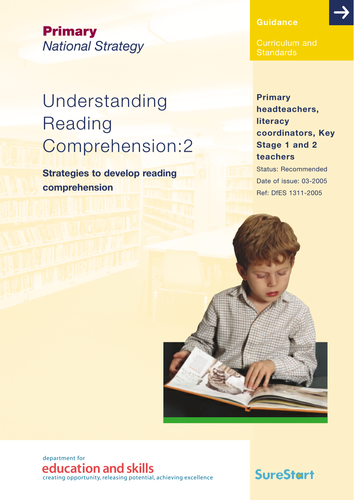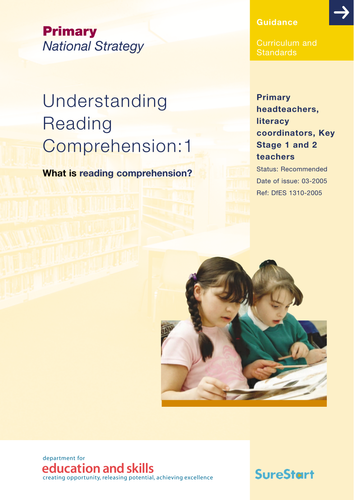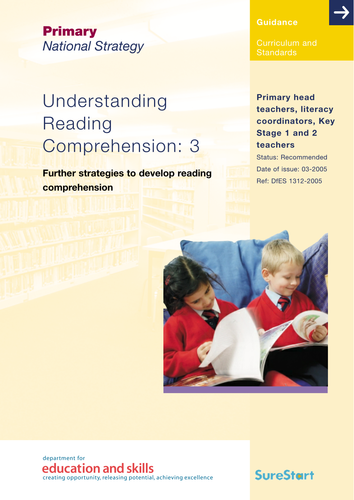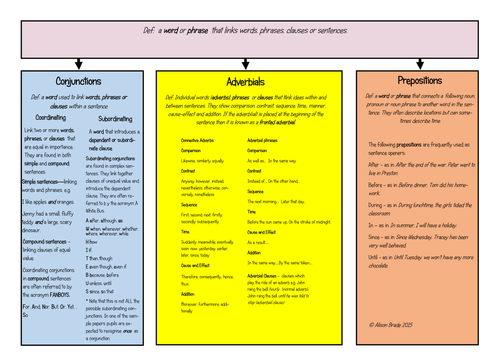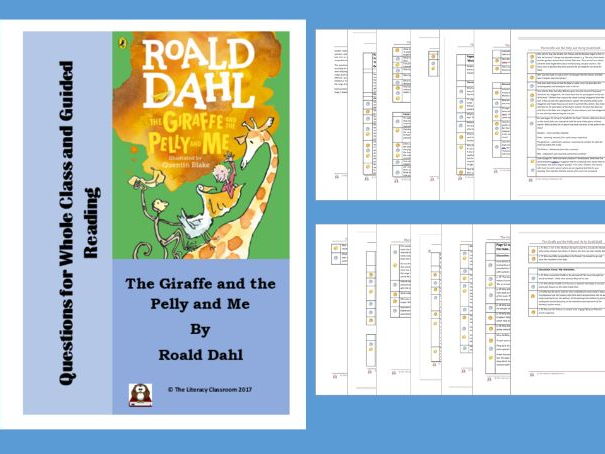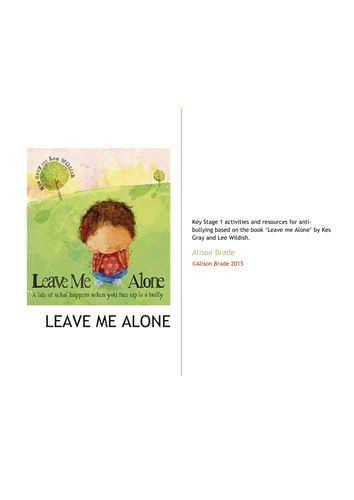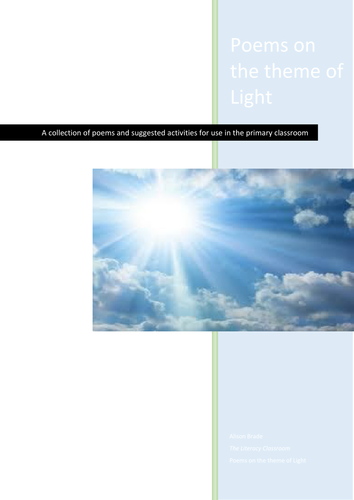
31Uploads
36k+Views
6k+Downloads
All resources

Understanding Reading Comprehension 2
This is the second of the reading comprehension documents published to support the national strategy. With the increased focus on inference and vocabulary skills it is important that we revisit these documents. This one identifies the strategies that effective readers use to comprehend a text:the skills we need to teach children if they are to develop their comprehension. It also makes some suggestions about how to teach each of the strategies.

Understanding Reading Comprehension 1
This is the first of the Reading Comprehension documents that was published to support the primary strategy. With an increased focus on inference and vocabulary in the 2014 curriculum, it is important that we revisit these documents to understand what comprehension is and how we can 'teach' it.
As children learn to read they are able to decode the text by orchestrating a range of
cues. To become fluent readers they must also understand or comprehend what they
read. To help them do this they need to be taught a range of reading comprehension
strategies and be encouraged to reflect on their own understanding and learning. Such
an approach helps children go beyond literal interpretation and recall to explore the
complex meanings of a text using inference and deduction. They can begin to learn
these strategies from the earliest stages of learning to read.
This leaflet will help you to understand how readers make sense of what they read,
review the research evidence and suggest ways to teach reading comprehension
strategies.

Understanding Reading Comprehension 3
The third comprehension document to support the national strategy. This particular one has some very useful information about how to develop children's vocabulary and their skills of understanding texts at 'word' level. The 2014 curriculum has an increased focus on this particular aspect of comprehension and the 2016 SATs also has an increased focus on word meaning.
It also suggests ways in which teachers can develop pupils understanding of character and theme as well as helping them make connections within and across texts.

What are connectives called in the new National Curriculum?
Are you confused by the terminology in the New National Curriculum? The fact that the term 'connectives' is no longer in the National Curriculum, has caused a great deal of angst and confusion for many teachers. This chart identifies what 'connectives' are now known as in the NC English 2014. It provides definitions and examples on a single sheet of A4 and is an at a glance prompt sheet for busy teachers.

The Giraffe and the Pelly and Me. Differentiated Questions for Whole Class and Guided Reading
This 14 page PDF includes differentiated questions for Roald Dahl's 'The Giraffe and the Pelly and Me.' The book has been split into 5 sections and there is a set of differentiated questions for each section. The questions are suitable for years 3 and 4 and could be used with the whole class or with smaller guided reading groups.
Each question is cross-referenced to the content domains used in the Key Stage 2 reading SAT and includes answers.

'Twas the Night Before Christmas: Comprehension and Vocabulary Activities
This is a Key Stage 2 reading SAT style comprehension based on the poem 'Twas the Night Before Christmas by Clement C Moore. It also includes the answers which follow the format of the SATs answer booklet, identifying the content domain for each question, possible answers and the number of marks available. There is also a crossword included in the pack which is differentiated 3 ways and allows pupils to practise identifying the meaning of the word from the context and is a useful fun way of preparing them for the find and copy type questions. I have also included a wordsearch, to help expose pupils more to the vocabulary used in the poem. This again is differentiated 3 ways and includes the solutions to each of the problems.
The activities included in the pack are suitable for Key Stage 2.

Daddy Fell into the Pond by Alfred Noyes. KS1 SATs style Comprehension and Vocab
This is a KS 1 SATs style comprehension paper based on the poem 'Daddy Fell into the Pond' by Alfred Noyes. It includes a copy of the poem ready for copying. The comprehension paper follows the format of the Key Stage 1 Reading Comprehension SAT and includes a marking key which identifies the content domain for each question plus acceptable answers. There is also a crossword which is differentiated 3 ways. This will provide the children with useful practice for the 'find an copy' vocabulary questions. The wordsearch (again differentiated 3 ways) provides further opportunity to engage with items of vocabulary taken from the poem.

Peter Pan Chapter 1 SATs-style Comprehension (with answers)
This resource contains an extract from chapter 1 of J. M. Barrie’s ‘Peter Pan’. To accompany this there is a Key Stage 2 SATs style comprehension. Each of the questions follows the format and structure of questions found on the 2016 and 2017 KS 2 Reading SAT. To aid marking there is a complete mark scheme which not only provides the answers but also identifies the target content domain for each question. I have also included a grid which clearly identifies coverage of the content domains for the whole of the paper.
The comprehension can be used as a stand alone practice activity for year 6 comprehension in preparation for the KS 2 Reading SAT or it could be used as part of a novel study unit on Peter Pan. As the extract from the text is included it is also ideal for homework. The comprehension is suitable for year 5 or year 6.

The Third Voyage of Sinbad the Sailor: KS 2 SATs style comprehension (with answers)
This resource contains an extract from Andrew Lang’s Arabian Nights, a KS2 SATs style comprehension and a complete marking key. This comprehension is based on the classic story of Sinbad the Sailor by Andrew Lang. For convenience the text is provided so that you can copy it enabling all children to have a copy. The comprehension follows the same layout as the KS 2 Reading SAT. The booklet includes a mark scheme which also identifies the targeted content domain for each of the questions.
The comprehension could be used as practice leading up to the KS 2 reading SAT either in class or as homework.

Winnie in Winter: Comprehension questions and activities & resources to support SPaG
This pack includes a set of comprehension questions to be used for whole class discussion/guided reading, suitable for year 2. The majority of the question focus on content domain 1d allowing teachers to develop the necessary skills before the year 2 SATs. There is also a focus on 1a, vocabulary.
The pack also includes suggestions for developing pupils grammar, punctuation and spelling. In particular: adjectives, noun phrases, sentence structure, sentence types (commands), use of commas to separate words in a list, the apostrophe for omission and the homophones their, there and they're.
All the resources for the activities are included: worksheets, smart notebook file for sentence construction, a class set of 30 bingo cards for contraction bingo, cards for composing human sentences etc.

Activities and Resources for KS1 anti-bullying based on 'Leave Me Alone' by Kes Gray
Some ideas for ant-bullying activities suitable for Key Stage 1 based on the book 'Leave Me Alone' by Kes Gray. The activities use the book as a stimulus to introduce this sensitive subject area. The activities focus on the characters in the book before broadening them out. It includes 2 powerpoint presentation resources to stimulate discussion of the key points in the story (or a smartnotebook alternative) and one worksheet for the children to complete.

Bill's New Frock: Differentiated Questions for Whole Class and Guided Reading
This is a bank of differentiated questions (with answers) for every chapter of Bill's New Frock by Anne Fine. They can be used for whole class reading or small group guided reading to facilitate discussion and develop children's comprehension skills. The questions have been differentiated three ways enabling teachers to target the level of challenge according to the needs of their pupils. Also each question has been cross referenced against the content domains for the key stage 2 SATs. The questions are suitable for pupils in year 4 or year 5.

Poems and activities on the theme of light for primary school
This is a pdf document. The document contains a collection of poems on the theme of light, suitable for use in the primary school. The poems are categorised according to the age group they might be used with. Each of the poems has suggested activities that can be carried out by the children, ranging from singing/performing the poems in reception to the study of figurative language in years 5 and 6. From year 1 through to year 6 there are suggestions as to how the children might go about composing their own poems using a range of poetic devices and figurative language using the selected poems as models.
The poems written by the children could then be used as a whole school poetry celebration which might take the form of an assembly, an anthology of poetry or a display.
The theme for National Poetry day 2015 is 'light' .

Pinocchio Chapter 17: KS2 SATs style comprehension and Vocabulary Activities
This KS 2 SATs style comprehension includes an extract from chapter 17 of the classic text Pinocchio. This can be copied for individual children. There is a comprehension paper which follows the format of the KS 2 reading SAT paper and a mark scheme is included which identifies the content domain targetted by each question. In addition there is a differentiated crossword for vocabulary development and a differentiated word search.
The comprehension provides useful practice for the Key Stage 2 reading SAT which could be used as a one-off lesson, as a lesson which forms part of a unit of work on the book Pinocchio or for homework.
The extract has an ATOS book level of 5.4, a lexile level of 700L-800L and a Flesch-Kincaid Grade Level of 5.

Aesop's Fables:The Fox and the Stork KS 1 Comprehension Style SATs Paper 2
This is a Key Stage 1 SATs style comprehension (paper 2) based on Aesop’s Fable, The Fox and the Stork. The text (which is included) is the original unabridged text and has a lexile level of 1000L. The questions follow the format of Paper 2 of the Key Stage 1 Reading SAT. Included is a grid identifying the coverage of the Key Stage 1 content domains for reading. The mark scheme is included saving you time. Also included is a word search.
The resource can be used as part of a unit on fables or as a stand alone lesson/homework.

Comprehending and Analysing Character
These charts are designed to be used to support the teaching of comprehension. In particular, inference. Through the use of these sheets children are encouraged to compare characters, examine how characters develop through the course of a story, draw inferences about character's feelings etc., from the things they say/do and justify their inferences with evidence. All the charts can be used throughout the whole of Key Stage 2 and are also suitable for use in year 2.
The charts/worksheets included in this resource can be used alongside any piece of fiction.
They can be used with the whole class during shared reading; groups of children during guided reading or independently by individuals/groups of children.

Features of Fictional Narrative: A Guide for Teachers
The National Curriculum for English 2014 mentions only a few fictional genres specifically. However, the newly revised teacher assessment framework for writing clearly states that children at both Key Stage 1 & 2 should be drawing on their reading. With an in-depth knowledge of the structures and features that are associated with the different narrative fiction genres we can make much more informed decisions about the aspects we want to focus on for comprehension and for writing. This document sets out the different features of the most common fiction genres that are written for children, identifying common plot structures, character types, key language features and themes. This will enable teachers to plan more focused reading and composition lessons for their pupils.

Babouscka KS 2 SATs Style Comprehension & Vocabulary Activities
This pack contains the full printable script of Babouscka which was originally published in 1916, a Key Stage 2 SATs style comprehension paper complete with mark scheme, a crossword which is differentiated 3 ways and a word search which is also differentiated 3 ways.
The story has a lexile level of 800L-900L and a Flesch-Kincaid grade level of 6.11
It is suitable for most pupils aged 9 and over and could be used as a one-off lesson, homework or as part of a topic on Christmas legends/traditions.

The Wind in the Willows Chapter 2 KS 2 SATs style comprehension (with answers)
This resource contains an extract from chapter 2 of Kenneth Grahame's 'The Wind in the Willows'. To accompany this there is a Key Stage 2 SATs style comprehension. Each of the questions follows the format and structure of questions found on the 2016 and 2017 KS 2 Reading SAT. To aid marking there is a complete mark scheme which not only provides the answers but also identifies the target content domain for each question. I have also included a grid which clearly identifies coverage of the content domains for the whole of the paper.
The comprehension can be used as a stand alone practice activity in preparation for the KS 2 Reading SAT or it could be used as part of a novel study unit on The Wind in the Willows. Suitable for years 5/6.

Poppy Field by Michael Morpurgo: Questions for Whole Class and Guided Reading
This is a bank of questions to use alongside Michael Morpurgo’s ‘Poppy Field’. The questions are designed to facilitate discussion either with the whole class or small group guided reading. Each question is cross referenced to the Key Stage 2 content domains for reading. The story is a beautiful story written to commemorate the centenary of the First World War and relates to why we wear poppies on Remembrance
I have divided the story up into 5 parts to facilitate discussion but it isn’t necessary to do this. The questions are varied in the level of challenge ranging from straight forward literal comprehension to some challenging questions which focus on a close reading of selected sentences to challenge your most capable readers. Teachers should select which questions they feel are appropriate for different groups of children rather than aim to ask every single one.
Note the questions are for Michael Morpurgo’s story only and not the poem nor the Afterword.

